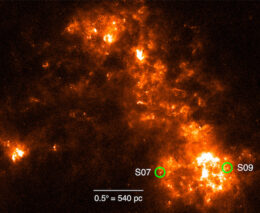Researchers have detected hot molecular cloud cores in the Small Magellanic Cloud for the first time. This discovery enhances our understanding of star formation in the nearby universe and will guide future explorations of extragalactic star-forming regions.
From Cold Cloud to Hot Core

A view of the Small Magellanic Cloud from the European Southern Observatory’s Visible and Infrared Survey Telescope for Astronomy. [ESO/VISTA VMC; CC BY 4.0]
The Small Magellanic Cloud is an interesting place to search for hot cores because this small, irregularly shaped galaxy is poor in metals — elements heavier than helium — compared to galaxies like the Milky Way. If we find hot cores in such a metal-poor galaxy, we can study how the formation of massive stars varies between metal-rich and metal-poor galaxies in the universe today. This can also help us understand star formation billions of years ago, when the universe was substantially less metal rich than it is now.

Locations of the two protostars/hot core candidates, S07 and S09, within the Small Magellanic Cloud. The observations were made at infrared wavelengths. [Shimonishi et al. 2023]
Core Candidates
Takashi Shimonishi (Niigata University) and collaborators began their search for hot cores with two sources in the Small Magellanic Cloud that had been flagged as high-mass protostars. Previous observations found that these two soon-to-be stars are swathed in clouds containing dust and ice, which suggests that the protostars might be embedded within dense gas.
The team combined new and archival data from the Atacama Large Millimeter/submillimeter Array (ALMA) to determine the properties of the gas surrounding the two sources. They detected spectral lines from numerous molecules and molecular ions, including carbon monoxide, methanol, and sulfur dioxide. The data suggested that the gas surrounding the protostars is dense, hot (here, “hot” means warmer than 100K), and concentrated in a small region around each protostar — exactly the characteristics of a hot core!
Testing Molecular Tracers
Finding hot cores in the metal-poor Small Magellanic Cloud suggests that hot core formation is an expected part of massive star formation for galaxies with a wide range of metal abundances. Specifically, Shimonishi and collaborators have shown that hot cores can form in galaxies in which metals are 80% less abundant relative to hydrogen than they are in the gas from which the Sun formed.

Comparison of the sulfur dioxide (SO2) and methanol (CH3OH) emission for the hot core S07. The source region of the sulfur dioxide emission is more compact and warmer. Click to enlarge. [Adapted from Shimonishi et al. 2023]
Citation
“The Detection of Hot Molecular Cores in the Small Magellanic Cloud,” Takashi Shimonishi et al 2023 ApJL 946 L41. doi:10.3847/2041-8213/acc031

